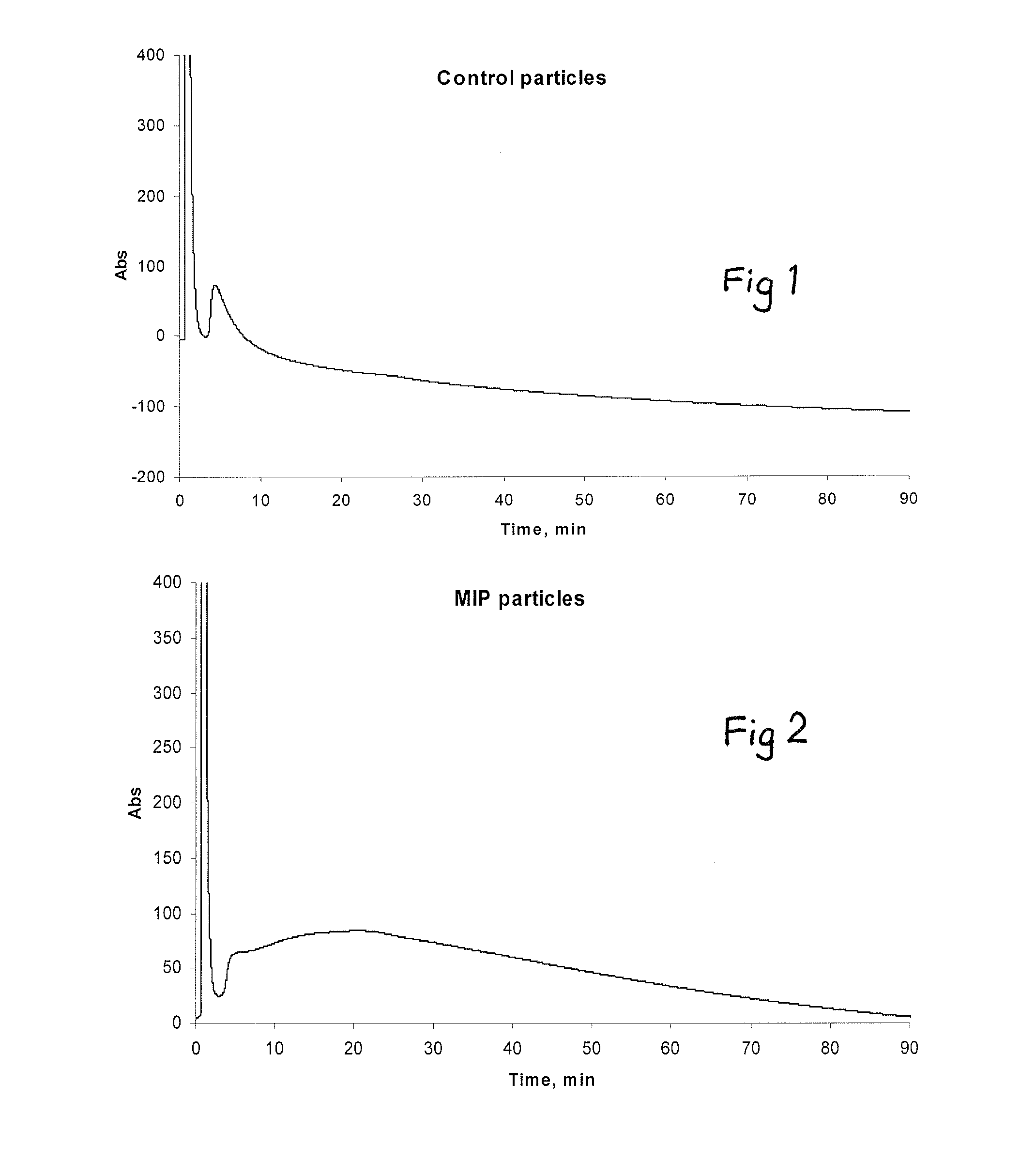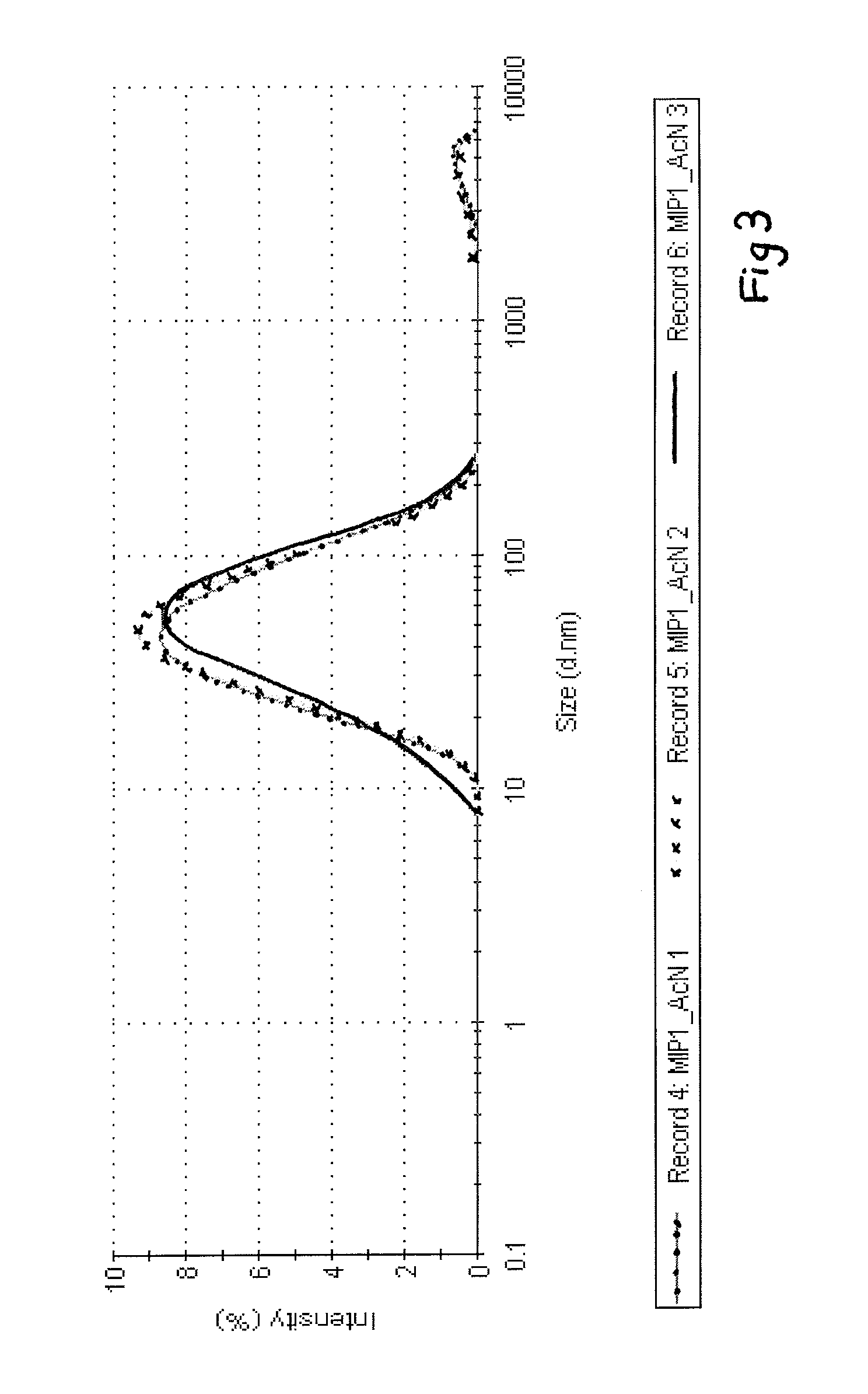Preparation of molecularly imprinted polymers
a technology of molecular imprinting and polymerization, which is applied in the field can solve the problems of limited use of molecular imprinting polymers (mips) in pharmacology and medicine, frequent need for templates, and large number of fractions of synthesized compounds with poorly controlled size and properties. achieve the effect of reducing the cost of mip preparation
- Summary
- Abstract
- Description
- Claims
- Application Information
AI Technical Summary
Benefits of technology
Problems solved by technology
Method used
Image
Examples
example 1
Synthesis of MIP Particles with Affinity to Melamine
[0073]A mixture of 1.17 g acetonitrile, 0.32 g methacrylic acid, 0.36 g trimethylolpropane trimethacrylate (TRIM), 0.36 g ethylene glycol dimethacrylate (EGDMA), 0.087 g diethyldithiocarbamic acid benzyl ester (living initiator) and 0.02 g pentaerythritol tetrakis(3-mercaptopropionate) (chain transfer agent) was purged with nitrogen and polymerised under UV radiation (UVAPRINT 100 CVI UV source with 0.163 W / cm2 intensity, Dr. Hönle) for 3 min inside a glass column (70×4 mm) packed with glass beads (9−13 μm diameter) derivatised with melamine. Blank (control) particles were synthesized the same way but the column was packed with bare glass beads of the same size. After polymerization the column was washed with 1 ml acetonitrile to elute nanoparticles and unreacted monomers. The resultant soluble imprinted nanoparticles had an average diameter of 60 nm as calculated by dynamic light scattering on a Nanosizer (Malvern Instruments). Th...
example 2
Affinity Separation of Synthesized Polymer
a) Preparation of Affinity Adsorbent—Immobilization of Template
[0074]Glass beads were activated by boiling in 4M NaOH during 10 min, washed with deionised water and acetone then dried at 80° C. for 2 hours. the beads were then incubated in toluene with 2% v / v (3-aminopropyl)trimethoxysilane for 3 hours, washed with acetone and placed in PBS, pH 7.2 with 7% v / v glutaraldehyde for 30 min and afterwards washed with water. The template (melamine) was then immobilized on the surface of the beads by incubation in a solution of PBS pH 7.2 with N-Methyl-2-pyrrolidone (10% v / v) and 0.1 g / ml melamine during 4 hours. The melamine coated particles were used for the synthesis of imprinted nanoparticles and for affinity chromatography.
[0075]The sample eluted from the glass column in Example 1 was filtered with a PTFE syringe filter with 0.22 μm pore size in order to remove any large polymer aggregates. To remove unreacted monome...
example 3
Preparation of Nanoparticles for Melamine
[0076]Glass beads (75 μm in diameter) were activated by boiling in 4 M NaOH for 10 minutes, then washed thoroughly with double-distilled water and acetone and dried at 80° C. for 2 hours. The beads were then incubated in 2% v / v solution of 3-aminopropyltrimethyloxysilane (APTMS) in toluene overnight, washed with acetone and incubated in 25 ml of a 5% v / v glutaraldehyde (GA) solution in PBS buffer pH 7.2 for 1 hour, and rinsed with double-distilled water. The template was immobilized by incubating the beads in 0.01 g / ml solution of melamine in PBS pH 7.2 with N-methyl-2-pyrrolidone (NMP) (10% v / v) for 4 hours. The excess of physically adsorbed melamine was removed by washing with double-distilled water and methanol. Derivatised glass beads were dried under vacuum and packed in a quartz column (6.4 mm o.d. with 1.5 mm wall, 150 mm length). 0.32 g methacrylic acid (MAA), 0.36 g trimethylolpropane trimethacrylate (TRIM), 0.36 g ethylene glycol di...
PUM
| Property | Measurement | Unit |
|---|---|---|
| particle sizes | aaaaa | aaaaa |
| molecular weights | aaaaa | aaaaa |
| molecular weights | aaaaa | aaaaa |
Abstract
Description
Claims
Application Information
 Login to View More
Login to View More - R&D
- Intellectual Property
- Life Sciences
- Materials
- Tech Scout
- Unparalleled Data Quality
- Higher Quality Content
- 60% Fewer Hallucinations
Browse by: Latest US Patents, China's latest patents, Technical Efficacy Thesaurus, Application Domain, Technology Topic, Popular Technical Reports.
© 2025 PatSnap. All rights reserved.Legal|Privacy policy|Modern Slavery Act Transparency Statement|Sitemap|About US| Contact US: help@patsnap.com


